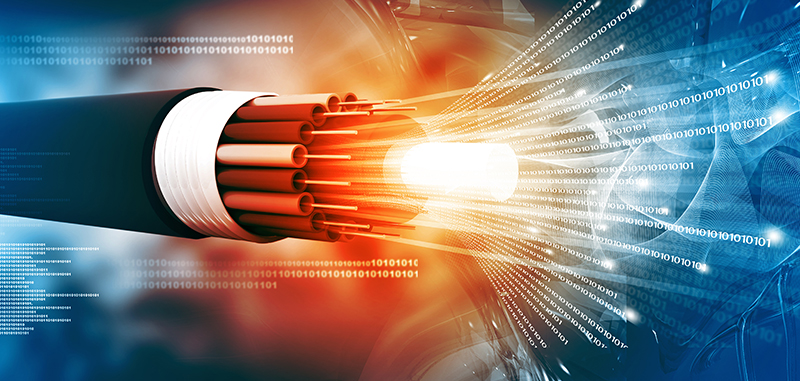
25 Apr How does fiber optics impact businesses?
Fiber optics (optical fiber), comprising thin strands of glass, is the channel used to transmit data, images, and voice in the form of a beam of light that pulse through tiny, transparent fibers. Earlier, telecommunications technology used copper wire for transmitting voice signals.
Because the stands are so thin, an entire fiber-optic cable allows for the transmission of several million calls. Presently, fiber optic cables power most of the internet, telephone systems and cable TV globally.
There are two main types of fiber cables, which are known as single mode and multi-mode fiber.
The following are the benefits of using fiber optics for transmission:
Fiber optics have a great ability to transmit signals of high speed over very long distances sans optical repeaters than cables of any other type. Their capability to transmit rises with frequency. Although it should not be presumed that fiber optics have unlimited bandwidth, it surely is larger than coaxial cables. Usually, the bandwidth limit of coaxial cables is around 10MHz/km, but the bandwidth of fiber optic cables are around 500MHz/km. It is one of the primary reasons that enterprises today choose optical fiber for data communications. If fiber is added to a dark fiber network or a wired network, it can reach terminals beyond its normal range.
Despite the ability of fiber optics to solve data communication issues, they are not required at all places. A major chunk of computer data travels over copper wires. For short distances, data is more often sent at low speed because it is not cost-effective when fiber optics are used to transmit data between PCs/laptops/mobile devices and printers.
Electromagnetic Interference (EMI), a common type of noise, stems from one of electromagnetism’s basic properties. EMI is, however, known for its occurrence in coaxial cables, as current breaches the conductor. Fiber optics are immune to EMI since signals are transmitted as light instead of current. Thus, they can carry signals through places where EMI would have blocked transmission.
A major problem with copper cables on some computer networks is that lightning can affect them, destroying wires and other cables related to the network. Computer firms aware of this problem try to fix it by putting in place protective devices so that wire circuits prevent surges in current and voltage.
All conductive cables are capable of carrying ground loops or power surges. But fiber optic cables can be made non-conductive if they do away with metal in their design. Such cables are standard and also economical for several indoor applications. Outdoor types of these cables are, however, more expensive as they need special strength members. They too defend electronic equipment from surge loss and can remove ground loops.
There are certain cases where it is highly unsafe to transmit signals electrically. Most electrical wires can create minor sparks. Although sparks do not pose any danger, they can be harmful in oil refineries or chemical workshops where potentially unstable vapors contaminate the air. One tiny spark is enough to cause a massive explosion. Possible spark dangers are a major hindrance to data and communication in facilities of those types. But with fiber optic cables, there is no prospect of sparks because they do not carry current.
As the transmission capacity of copper cables is increasing, it makes them thicker and more inflexible. It would be difficult to install cables of such type in existing buildings where they need to travel through cable ducts and walls. In these cases, fiber cables can easily be installed, as they are more malleable and smaller. Additionally, when they traverse along the same routes as electric cables, they do not raise excessive noise.
To make it easier to install cables in existing buildings, they need to run them via ventilation ducts. But fire codes mandate that such cables must be made of expensive fire retardant resources because they emit little smoke. Here, it is better to install fiber cables, as they are smaller, and so need less of the expensive fire retardant materials. Besides, as fiber optic cables are light in weight, smaller in size, and highly flexible, it is easier to use them for portable and temporary installations.
The significant advantages of using optical fibers are that power loss is insignificant, allowing signals to be transmitted additionally. Since the loss of optical fibers to the signal is around 0.3 dB/Km, there is no need for optical repeaters for long distances.
Most optical fibers that are used are made of sand, silica or other raw material, which is abundantly available, unlike copper. This makes fiber optic cables much cheaper than copper ones, and so it is cost-effective to install new wires.
As fiber optic cables are lighter and slimmer than copper wires, they can be used in limited pathways, or at other places where weight and the largeness is a burden.
Moreover, optical fibers are not easy to tap unless the signal is disrupted; they are, therefore, more secure.
If all these factors are taken into consideration, it makes sense for businesses to opt for fiber optic cables.
About the Author:
Krishna Reddy is a Staff Author at FieldEngineer.com, a Marketplace for On-Demand telecom workforce, ranging from field engineers to high-level network engineers, project managers and Network Architects in 162 countries. He is a Computer Science Graduate. Krishna understands the ongoing technology trends and keeps himself updated in the technology industry.


Sorry, the comment form is closed at this time.